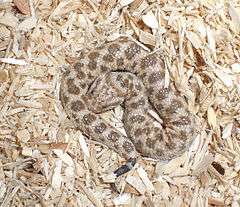Caudal luring

Caudal luring is the use of tail movements by a predator to attract prey animals.
Aggressive mimicry
Caudal luring is a form of mimicry classified formally as aggressive mimicry,[1] but perhaps better described by the term feeding mimicry.[2] It is also an example of deception in animals. The behaviour is employed by a number of snake species and allegedly by two lizards, though other interpretations (e.g., distraction)[3] seem more plausible for the lizards. Caudal luring also occurs in a shark, the tasselled wobbegong, Eucrossorinus dasypogon and very likely in the pelican eels, Eurypharynx, which possess a bioluminescent tail tip. The behavior is associated with sedentary predators whose diets include animals susceptible to a worm-like (or fish-like, in the case of Eucrossorinus and perhaps Eurypharynx) luring appendage. Snakes generally lure small ectotherms (e.g., frogs and lizards), although luring of birds has been demonstrated (Spider-tailed horned viper) and luring of insectivorous mammals is suspected. Caudal luring occurs most often in juvenile snakes and is most prevalent in vipers and pitvipers,[4] but it also occurs in boas, pythons, tropidophiids, colubrids, and elapids of the genus Acanthophis.[5][6]
Caudal luring has been used as an experimental paradigm to investigate stimulus control and visual perception[7][8] in viperid snakes. It has been suggested that caudal luring was involved in the evolution of the rattlesnake rattle.[2] Attempts have been made to test this hypothesis,[9] however, the evidence is contentious. There have been dubious reports of caudal luring and concomitant speculations.[10]
Prey luring in general is a field muddled by false identification. The difficulty is that there are a number of other behavioural interpretations for a wiggling appendage, and luring-like motions are associated with several other behavioural contexts (e.g., defence, stress, etc.). Caudal luring is thought to have evolved from a caudally localised intention movement[8] (a behaviour derived from locomotor movements). Essentially, the act of remaining stationary while sensing prey produces general nervous system excitation that gets released in the form of tail movements. Caudal luring is not merely tail undulations, but must specifically be attractive to prey. Caudal distraction[3] is another behaviour used by snakes, and the tail motions are very similar to caudal luring. The difference is in the snake's posture and especially in the nature and outcome of the behaviour in reference to the encounter with prey. Other caudal luring-like movements occur as warning signals and are induced by stressful circumstances. Thus identifying caudal luring entails observing the effect that tail movements have on prey species, a burden of evidence that is woefully lacking in much of the literature on this intriguing behaviour.
References
- ↑ Vane-Wright RI. 1976. A unified classification of mimetic resemblances. Biological Journal of the Linnean Society 8: 25-56.
- 1 2 Schuett GW, Clark DL, Kraus F. 1984. Feeding mimicry in the rattlesnake Sistrurus catenatus, with comments on the evolution of the rattle. Animal Behaviour 32:625-626.
- 1 2 Mullin SJ. 1999. Caudal distraction by rat snakes (Colubridae, Elaphe): A novel behaviour used when capturing mammalian prey. Great Basin Naturalist 59: 361-367.
- ↑ Heatwole H., Davison E. 1976. A review of caudal luring in snakes with notes on its occurrence in the Saharan sand viper, Cerastes vipera. Herpetologica 32:332-336.
- ↑ Carpenter CC, Murphy JB, Carpenter GC. 1978. Tail luring in the death adder, Acanthophis antarcticus (Reptilia, Serpentes, Elapidae). Journal of Herpetology, 12:574-577.
- ↑ Chiszar DD, Boyer D, Lee R, Murphy JB, Radcliffe CW. 1990. Caudal luring in the southern death adder, Acanthophis antarcticus. Journal of Herpetology 24:253- 260.
- ↑ Reiserer, R. S. and G. W. Schuett (2008) Aggressive mimicry in neonates of the sidewinder rattlesnake, Crotalus cerastes (Serpentes: Viperidae): stimulus control and visual perception of prey luring. Biological Journal of the Linnean Society 95:81-91(11).
- 1 2 Reiserer, R. S. 2002. Stimulus control of caudal luring and other feeding responses: A program for research on visual perception in vipers, Pp. 361-383 in Schuett, G.W., M. Höggren, M. E. Douglas, and H. W. Greene (eds.), Biology of the Vipers, Eagle Mountain Publishing, Eagle Mtn., Utah.
- ↑ Sisk NR, Jackson JF. 1997. Tests of two hypotheses for the origin of the crotaline rattle. Copeia 1997:485-495.
- ↑ Tiebout HM, III. 1997. Caudal luring by a temperate colubrid snake, Elaphe obsoleta, and its implications for the evolution of the rattle among rattlesnakes. Journal of Herpetology 31:290-292.
